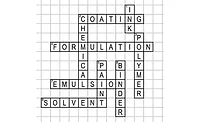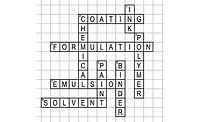Saul's Gloss Loss Solution

In Saul’s Gloss Loss Problem, Saul Vance had changed the coupling solvent in the water-reducible alkyd formulation from ethylene glycol butyl ether (EB) to ethylene glycol propyl ether (EP) when he discovered the EB solvent came out of aqueous solution at the elevated cure temperature. Lindsay Doyle explained that EB solvent exhibited a Lower Critical Solution Temperature (LCST) that caused the coating to lose gloss upon cure. Now the EP solvent was demonstrating the same problem. Even though EP solvent didn’t have a LCST, what was the other critical property that caused the loss of gloss?
Saul Vance knew that when applying waterborne coatings, like his water-reducible alkyd, controlling the humidity of the air is critical. The evaporation of water is directly related to the relative humidity of the air. Unlike the evaporation rate of most solvents, which is not affected by the relative humidity, the relative evaporation rate (RER) of water decreases linearly at 25º C from 0.31 RER at 0 relative humidity to 0 RER at 100% relative humidity. The higher the moisture in the air above the wet applied coating, the slower the water comes out of the coating film.
Saul Vance also knew that the way air moisture is measured is by relative humidity. The relative humidity of the air is a measure of how much water vapor is in the air at a particular temperature compared with how much water vapor would be in the air at saturation. It is expressed as a ratio of the amount of water in a given amount of air divided by the maximum amount of water the air can hold at that temperature. The ratio is multiplied by 100 and expressed as a percentage.
Al Kidd had visited the paint plant applying the coating. He knew that the owners had installed a state-of-the-art air handling system that controlled the humidity in the coating operation. He had also talked to the plant engineer and learned that the owners had not upgraded the plant insulation during the installation of the air handling equipment. The plant engineer reported that the outside temperature disrupted the temperature during coating, especially during the summer heat and winter cold. The engineer said the expensive air handling units did keep the vapor content in the plant air constant.
Saul's Gloss Loss Solution
For access to more podcast episodes, click here.
Al told Saul that besides some glycol ethers having a Critical Lower Solution Temperature (LCST), many glycol ethers, like EB and EP, have relative evaporation rates between the extremes of the evaporation rate of water when varying the RH from 0 to 100%. EB has a relative evaporation rate of 0.08 while EP is more than twice as fast in evaporating with a relative evaporation rate of 0.2. Both have an RER less than the fastest RER for water at 0.31. For a blend of 15% EB and 85% water typical of the water-reducible alkyd during the flash-off phase, the relative humidity when the water and EB come off at the same speed, referred to as the Critical Relative Humidity (CRH), is approximately 82 %. When the relative humidity is lower than 82%, water comes off faster than EB and the coating becomes enriched in EB solvent. This solvent enriching is most often preferred to allow the coating to stay soluble and the pigments to stay dispersed during the drying process.
The plant engineer had reported to Saul that the outside temperature had decreased dramatically for several nights before the gloss loss occurred. Al knew that the cold nights would decrease the temperature in the plant. Saul had assumed incorrectly that the relative humidity goes down with temperature since air doesn’t hold as much water at low temperatures. Al knew that since relative humidity is a ratio percentage, this temperature decrease has an inverse effect on relative humidity in the plant. The cooler temperature causes the relative humidity to increase. Cool air can’t hold as much water vapor (moisture) as warm air. Since relative humidity is a measure of the percentage saturation of the air, colder air doesn't require as much moisture to become saturated as warmer air. Since the amount of moisture in the plant air didn’t change and the absolute humidity is the same, the plant air will have a higher relative humidity when the air is cooler.
When Saul changed the solvent from EB to EP, the blend of 15% EP and 85% water has identical relative evaporation rates when the relative humidity is 55%. Now the Critical Relative Humidity for the EP and water is much lower and very close to the plant operating relative humidity of 50%. As long as the plant RH was less than the CRH of the glycol/ water blend, the formulation performed well and exhibited high gloss. As with the aqueous EB solvent earlier, when the relative humidity in the plant was below 55%, the water evaporated faster than the EP tail solvent, and the EP enriched the coating during the flash-off.
The unseasonably cool nights caused the temperature to drop in the plant and the relative humidity increased to above 55%. Now, with the RH of the plant above the CRH of the EP/water blend, the water comes off slower than the EP solvent, and the coating is depleted of the EP coupling solvent.
Al recognized how the cooler nights caused the shift in the evaporation rate of the EP and the water. Now the EP is too fast compared with the water. Because there is no coupling solvent left in the alkyd to act as a tail solvent and to help dissolve the resin, the resin precipitates out of solution, and the pigment agglomerates before the film is formed. This results in a coating with low gloss.
Another way to ensure that the relative humidity is not a cause of coating film problems is to vary the air speed above the coating during the flash-off. The relative evaporation rate of water as well as the relative rate of evaporation of blends of water and glycol ethers depends on the air speed. Critical Relative Humidity is dependent on the air speed. Often with aqueous glycol ether blends, increasing the air speed during flash-off will decrease the Critical Relative Humidity of the blend. For example, a 15% EB/85% water blend has a CRH of 82% without any air movement above the film, but the CRH drops to 62% when the air speed is 2 miles per hour. Then when the air speed increased from 2 mph to 6 mph, the CRH drops to 48%. A change in air speed or a change in relative humidity may be used to get the same effect. Coating problems like sagging can often be minimized by balancing the coating conditions, like air speed and temperature, against relative humidity.
The way most formulators ensure that humidity doesn’t cause a problem is to use glycol ethers that are slower than EP and have a larger Critical Relative Humidity with water. These solvents almost always enrich in solvent and deplete in water during the flash-off and rarely cause loss of gloss. If Saul had left EB solvent in the aqueous blend, this blend would have had a CRH of about 85%, well above even the resulting CRH after the cool nights. Because the RH would have been less than 85%, the EB would still be slower than the water. This solvent enriching effect on the coating would have kept the gloss high even with the colder temperature. But the EB was changed because it demonstrated the Lower Critical Solution Temperature at the elevated temperature in the bake.
In this example, Saul needed to be aware of two critical concepts, Lower Critical Solution Temperature, and Critical Relative Humidity. Both of these concepts are critical for all waterborne coating formulators to recognize and know how to control during the different stages of drying: application, flash-off, and baking.
For further information see: Dillon, Paul; “Application of Critical Relative Humidity, an Evaporation Analog of Azeotropy, to the Drying of Water-Borne Coatings”, Journal of Coatings Technology, Vol. 49, No. 634, November 1977.
Looking for a reprint of this article?
From high-res PDFs to custom plaques, order your copy today!








